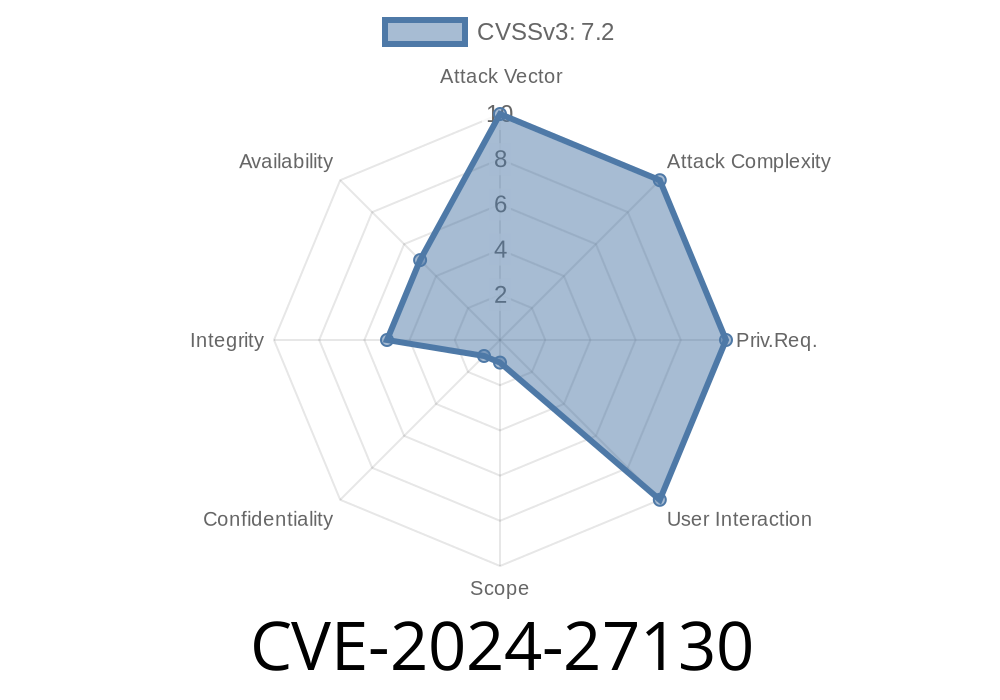In early June 2024, a new security vulnerability labeled CVE-2024-27130 was disclosed for QNAP’s widely used network storage systems. This flaw, found in multiple versions of QNAP's QTS and QuTS hero operating systems, is both simple and dangerous: it allows remote code execution via a basic buffer copy operation that fails to check the size of incoming data. In this blog post, we’ll break down what that means, why it can be exploited over the network, see how typical exploit code works, and point out what you should do to patch your system.
What is CVE-2024-27130?
This vulnerability falls into a classic category of programming bugs called buffer overflows. In these bugs, a program uses functions like strcpy() or memcpy() to copy user-provided data into a fixed-size buffer without making sure that the data isn’t too large. This can allow an attacker to overwrite adjacent memory, which often results in code execution.
The Official Advisory
QNAP’s official security advisory for CVE-2024-27130 is here:
https://www.qnap.com/en/security-advisory/qsa-24-23
QuTS hero: All versions before _h5.1.7.277 build 20240520_
If your QNAP device is running an earlier OS version, you’re at risk and should update immediately.
Technical Details: What Happened?
The core issue is a routine in the QNAP OS webserver component that copies user-submitted data (such as a login field or network request) into a local buffer. It did not check how much data was being copied, which means that a clever attacker could send a specially crafted request that is bigger than the buffer, overwriting critical memory regions.
Here's a simplified example in C that shows the bad code pattern
void vulnerable_function(char *user_input) {
char buffer[256];
// Problem: strcpy() copies without checking for buffer size!
strcpy(buffer, user_input);
// ... do something with buffer ...
}
If user_input is longer than 256 bytes, it will overwrite the buffer and keep writing over any memory that comes next. An attacker can exploit this to sneak in executable code or overwrite important system values.
How Can This Be Exploited?
A real-world attack would involve sending a network packet or HTTP request to the web server exposed by the QNAP device. The attacker would:
1. Craft a payload both longer than 256 bytes _and_ that contains a small piece of machine code (called "shellcode").
Send the payload via a vulnerable network API or web interface.
3. Gain code execution: If the overwritten memory is mishandled, the attacker can hijack the instruction pointer (EIP/RIP) and make the device run the shellcode.
A proof-of-concept attack (this is only for educational purposes!) could look like this in Python:
import socket
shellcode = b'\x90' * 100 # NOP sled
shellcode += b'\xcc' * 50 # (For demo: INT3 instructions, would be real shellcode)
# Offset to overwrite return address (depends on analysis)
buffer = b'A' * 256 + b'B' * 8 + shellcode
with socket.create_connection(('victim.nas.local', 808)) as s:
request = b"POST /vulnerable_endpoint HTTP/1.1\r\n"
request += b"Host: victim.nas.local\r\n"
request += b"Content-Length: %d\r\n\r\n" % len(buffer)
request += buffer
s.sendall(request)
(Again, this is educational only—do not use on systems you do not own!)
Why is This So Serious?
Because QNAP devices are often exposed on both home and corporate networks, a remote attacker could break into your device from anywhere. Once in, they could steal data, ransom files, or pivot to other machines on your network.
How Do I Fix It?
QNAP has released patches.
QuTS hero h5.1.7.277 build 20240520 or later
Check your device’s firmware and apply the latest updates from the QNAP site or your admin dashboard.
QNAP Download Center:
https://www.qnap.com/en/downloads
Further Reading & References
- QNAP Security Advisory for CVE-2024-27130
- QNAP Download Center
- A Guide to Buffer Overflows
Summary
CVE-2024-27130 is a critical buffer overflow flaw in QNAP OS that allows an attacker to execute code through a simple network request. It’s easy to exploit and affects many devices, but a fixed update is available. Upgrade now to QTS 5.1.7.277 or newer to stay protected.
If you are a QNAP device owner or admin, treat this vulnerability as a top priority. Patch now, and stay safe!
Timeline
Published on: 05/21/2024 16:15:25 UTC
Last modified on: 06/04/2024 17:46:20 UTC
